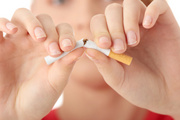 Photo: Getty Images
Photo: Getty Images
I would expect a medical journal named “Pharmaceutical Research” to focus exclusively on drugs, but that's not the case. I was delighted to find that a group of authors from The University of Texas M.D. Anderson Cancer Center published a comprehensive review article on lifestyle factors that can prevent cancer in this journal.
Genetic defects account for only 5-10 percent of all cancer cases, they claim. As examples of the evidence, they point to two observations: (1) people who move to a different country are likely to be diagnosed with chronic illness common to where they live, not where they came from, and (2) the concordance between identical twins was found to be only 20 percent for breast cancer.
Here's how the M. D. Anderson researchers categorize our cancer risk factors:
1. Diet, 30 – 35 percent
2. Tobacco, 25 – 30 percent
3. Infections, 15 – 20 percent
4. Obesity, 4 – 6 percent
5. Other environmental factors, 10 – 15 percent
6. Genes, 5 - 10 percent
The other environmental factors include air pollution from polycyclic aromatic hydrocarbons (PAH), second-hand smoke, formaldehyde, benzene, 1,3-butadiene, nitrates, pesticides, dioxins, and organochlorines. Radiation risks include X-rays (that's why you get the lead apron at the dentist's office, and the technician moves behind the barrier), radon in homes and workplaces, excessive sunlight and tanning lamps, and even nuclear fallout (as in the Chernobyl accident).
The authors of Reference 1 suggest, inflammation is the link between environmental factors and cancer. In Reference 2, Paul Ewald suggests infections are responsible for more cancers, as well as other chronic illnesses, than we yet realize. There is a strong connection between these two viewpoints, since inflammation is the normal response to infection.
I hope these insights will lead to more successful research on preventing cancer. For now, the recommendations are:
1. Do not smoke, and stay away from second-hand smoke!
2. Exercise and keep your weight in the optimum range.
3. Eat more fruits, vegetables, and whole grains; less meat and processed food.
4. If you drink alcohol, limit consumption to one drink per day.
5. Limit sun exposure, and don't get burned.
6. Get regular check-ups.
7. Practice infection control. Get vaccinations, and use excellent hygiene when you may be exposed to infection (as in public places in flu season).
Reference:
1. Anand P et al, “Cancer is a Preventable Disease that Requires Major Lifestyle Changes”, Pharmaceutical Research 2008 September; 25(9): 2097-2115.
2. Paul W. Ewald, “Plague Time: How Stealth Infections Cause Cancers, Heart Disease, and Other Deadly Ailments”, The Free Press, 2000.
Linda Fugate is a scientist and writer in Austin, Texas. She has a Ph.D. in Physics and an M.S. in Macromolecular Science and Engineering. Her background includes academic and industrial research in materials science. She currently writes song lyrics and health articles.





Add a CommentComments
There are no comments yet. Be the first one and get the conversation started!